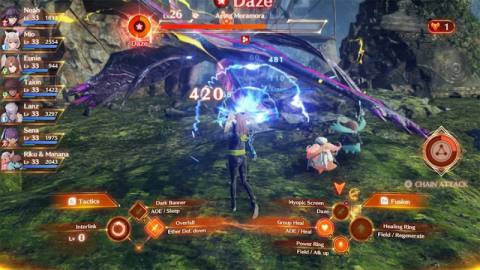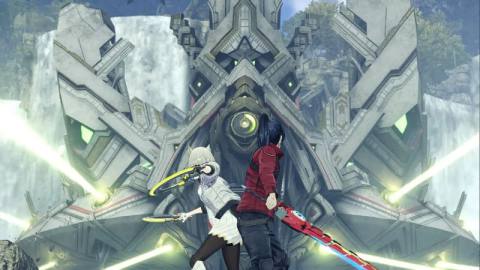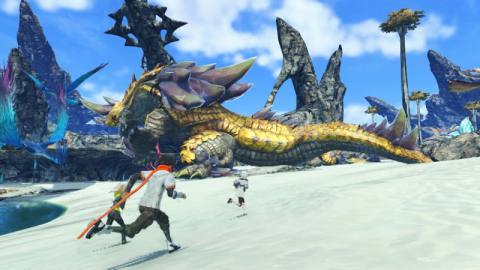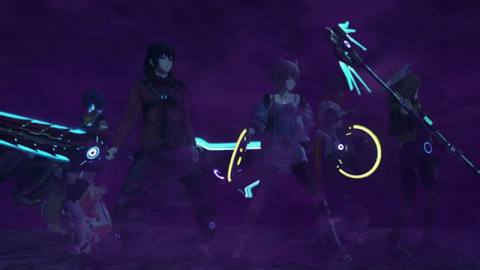
Platform: Switch
Publisher: Nintendo
Developer: Monolith Soft
Release:
The world of Aionios is in a perpetual state of war, endlessly engulfed in flame and littered with corpses. Countries Keves and Agnus love to hate each other, and both factions’ armies pay the price. To make matters worse, these seemingly mass-produced soldiers are cursed with short, 10-year lifespans. The goal, then, is to endure front-line service and be forever immortalized in the Homecoming ceremony, an honorable send-off for Aionios’ most tenacious survivors.
I meet Noah, Eunie, and Lanz, during the latter stage of their lifespans (or terms). The leading trio has slain their fair share of Agnusians and watched many beloved comrades fall in turn. So, when they join forces with Agnus operatives Mio, Sena, and Taion during the final minutes of Chapter 1, it feels as if all bets are off the table. In a time when one “lives to fight and fights to live,” the six leads seek out a more meaningful, fulfilling destiny.
Narratively, I’m immediately reminded of Tales of Arise – two races are pitted against one another, blinded by trauma and rage, unable to question the hateful rhetoric at the crux of their bloody conflict. Xenoblade Chronicles 3 tells a grim story. While its opening hours suffer from a few jarring momentum shifts and unconvincing plot beats, I’ve generally enjoyed learning more about Aionios and its youthful cast of characters.
However, I’ve enjoyed using the JRPG’s various quality-of-life features even more. Intricate but overly-complex menu interactions bogged down past games in the franchise. The third entry is tailored for a modern audience. I’m talking in-game GPS routes, a customizable shortcut hotbar with button mapping, more concise pause menus, and player-character orientation icons for position-based combat arts. These might be minor inclusions for the Xenoblade uninitiated, but this newfound level of accessibility is a welcome change that makes exploration and battles less intensive.
In Chapter 1 alone, I trudged through a bomb-cratered desert, swam in clear, open waters, traded with a vendor in a small military encampment below a towering robot, engaged in wonky platforming in some rocky highland, and navigated a sickly forest shrouded in mist. The biomes overflow with aerial and terrestrial beasts, from massive birds to armored insectoids. I collected items scattered around the game world, completed fetch quests for NPCs, and “sent off” fallen troops by playing a ceremonial flute tune.
I spent most of my time battling creatures and automatons for drops and experience points. Xenoblade Chronicles 3’s combat is methodical and rhythmic. Auto-attacks can be “canceled” (or chained) with role-specific arts like Noah’s various sword strikes and Eunie’s group-healing powers. These abilities build the gauges of “talent arts” or specials when employed effectively. Certain cross-character combos can stagger enemies, causing them to topple or launch.
And then there’s the interlink system: Two party members – Noah and Mio, Eunie and Taion, Lanz and Sena – fuse into a humanoid mech, otherwise known as Ouroboros, with devastating moves. So far, I’ve only played as an Ouroboros in a boss fight, but using its fiery and earth-shattering attacks was a fun power trip. With six party members to control on the fly and role-swaps that give even basic encounters an amusingly chaotic quality, I’m eager to see what new mechanics await beyond Xenoblade Chronicles 3‘s extensive tutorial Chapter.
I’m eleven hours into the story, and with the main cast on the run from their respective factions, I’m looking forward to meeting the famed “heroes” that help spice up the action, interacting with my various companions at makeshift camps, and learning who the “true enemy” is. There will likely be dozens more sprawling environments to navigate and legendary monsters to trounce, but so far, Xenoblade Chronicles 3 is shaping up to be a solid, albeit conventional, threequel.
Xenoblade Chronicles 3 launches on Switch July 29.





